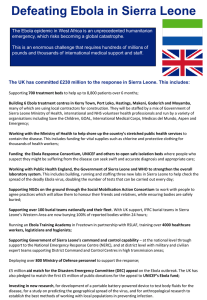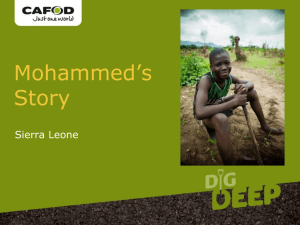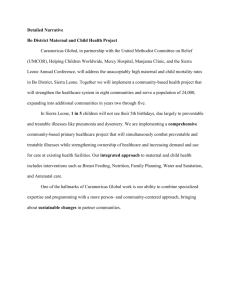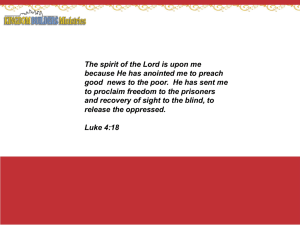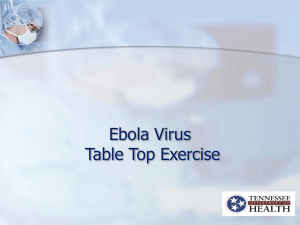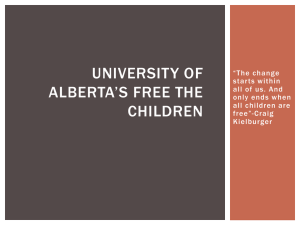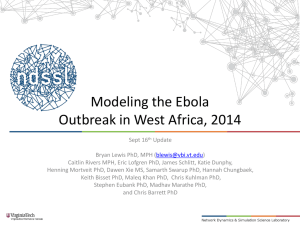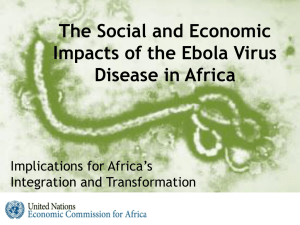20150308_kambia_forecariah_mou_annexes_en (English)
advertisement
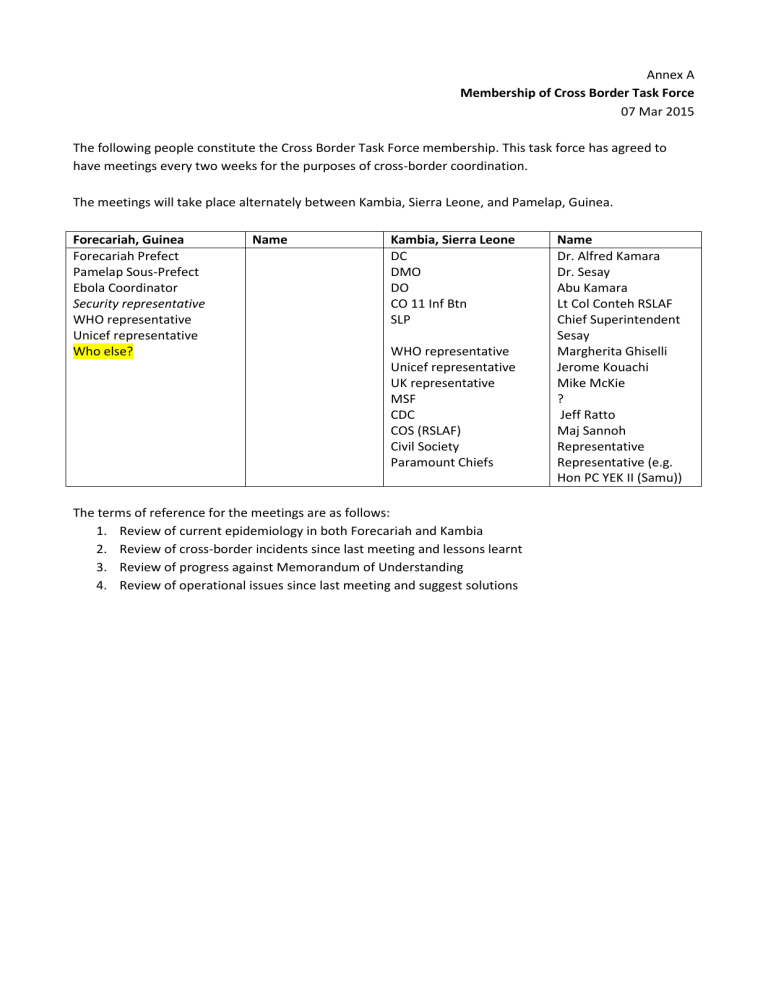
Annex A Membership of Cross Border Task Force 07 Mar 2015 The following people constitute the Cross Border Task Force membership. This task force has agreed to have meetings every two weeks for the purposes of cross-border coordination. The meetings will take place alternately between Kambia, Sierra Leone, and Pamelap, Guinea. Forecariah, Guinea Forecariah Prefect Pamelap Sous-Prefect Ebola Coordinator Security representative WHO representative Unicef representative Who else? Name Kambia, Sierra Leone DC DMO DO CO 11 Inf Btn SLP WHO representative Unicef representative UK representative MSF CDC COS (RSLAF) Civil Society Paramount Chiefs The terms of reference for the meetings are as follows: 1. Review of current epidemiology in both Forecariah and Kambia 2. Review of cross-border incidents since last meeting and lessons learnt 3. Review of progress against Memorandum of Understanding 4. Review of operational issues since last meeting and suggest solutions Name Dr. Alfred Kamara Dr. Sesay Abu Kamara Lt Col Conteh RSLAF Chief Superintendent Sesay Margherita Ghiselli Jerome Kouachi Mike McKie ? Jeff Ratto Maj Sannoh Representative Representative (e.g. Hon PC YEK II (Samu)) Annex B Forms 07 Mar 2015 Within this annex are the proformas to be used by those conducting surveillance and response work on the Guinea/Sierra Leone Border between Forecariah and Guinea. The forms below are as follows: 1. Cross-border Information Form (French and English) for use when a confirmed case that has links across the border. a. In the case of a confirmed case that has links across the borders, the investigation team will call the Alert line to inform of the need for cross-border investigation/contact tracing: i. Forécariah Alert desk: +224 694188129 or +224 624188130 ii. Kambia Alert desk: +232 77845479 or +232 77842507 b. The receiver of the Alert will inform MSF in Kambia or the WHO lead in Forécariah. In Forécariah, the WHO lead will assign an investigator for the case and will inform the MSF team by sending a text message to the following telephone number: +232 79515704; or sending an e-mail to: evdbordersil@gmail.com c. The investigation team will complete the “Cross border investigation form” (below), including the minimum information needed for the investigation/contact tracing across the border and the contact details of the case and surveillance officer. In Kambia, the investigator will give the completed form to the MSF team, who will translate it into French. d. The WHO investigator (in Forécariah) or the MSF team (in Kambia) will forward the completed form by e-mail to: i. evdbordersil@gmail.com (password: whowhowho) – Kambia, Sierra Leone ii. ebolabordergui@gmail.com (password: omsomsoms) – Forécariah, Guinea e. The investigation teams across the borders will communicate regularly by telephone during the follow-up. A joint investigation team may be formed, if possibl Fiche d’information transfrontalière Nom/prénom du cas Date: Numéro d’identification Sommaire du cas: Age Genre Statut du cas (vivant ou décédé) Adresse et pays du domicile Préfecture/District Numéro de téléphone du cas et de la famille Cas source: nom/prénom, adresse, no d’identification Eléments d’importance transfrontaliers: Début des symptômes Date d’hospitalisation Centre hospitalier Information disponible sur les contacts (adresse de contacts) Point focal (Sierra Leone et Guinée) et numéro de téléphone Cross border investigation form Surname/name of case Date of completion: Identification number Case summary Age Gender Status (alive or dead) Address and country of residence Prefecture/District Telephone number of case and of the family Source case: surname/name, address, identification number Important information for crossborder investigation Date of onset of symptoms Date of hospital admission Name of Holding/Treatment centre Available information on contacts (address of contacts) Name of investigator (Sierra Leone and Guinea) and telephone number Annex C Directory of Contacts 07 Mar 2015 Countr y Location Description Surname Name E-mail address Telephone Mounir Sarata National/ Internation al NAT NAT Guinea Guinea WHO Epidemiologist /MG WHO Epidemiologist /MG SYLLA CONDE mounirgas@gmail.com conesarata@gmail.com 624 617 907 624 617 776 Guinea WHO Epidemiologist /MG DIALLO Aguibou NAT draguibou@gmail.com 624 617 788 Guinea WHO Epidemiologist /MG DIALLO NAT monembo7@gmail.com 624 617 820 Guinea WHO Epidemiologist /MG SYLLA NAT aissatadaouda90@gmail.com 624 617 782 Guinea WHO Epidemiologist /MG TOURE Thierno Saidou Aissata Daouda Ousmane NAT drotoure@gmail.com 624 617 836 Guinea WHO Epidemiologist /MG KAMANO Aly Antoine NAT aantoinekamano@yahoo.fr 624 617 798 Guinea WHO Epidemiologist /MG KOULIBALY Mamadi NAT mdkoulibaly@yahoo.fr 624 617 799 Guinea WHO Epidemiologist /MG MILLIMONO NAT millimounotambajacques@yahoo.com 624 617 906 Guinea WHO Field Coordinator OMS TWAHIRWA Tamba Jacques Gerard INT gtwahirwa@gmail.com 621 845 378 Guinea WHO Epidemiologist /MG KOUROUMA Fode Sory NAT docteuridal@yahoo.fr 624 617 882 Guinea WHO Epidemiologist /MG Pascal NAT 624 82 80 95 Superviseur de proximité Dr Nanfadima Condé +224 664 88 32 16 Superviseur de proximité Dr Ansoumane Cissé +224 664 35 39 88 Guinea Commune Urbaine Maférinya h Kaliah Superviseur de proximité Dr Fassouma Mara +224 655 59 06 49 Guinea Allassoyah Superviseur de proximité Dr Mohamed Camara +224 621 62 59 33 Guinea Guinea Guinea Benty Superviseur de proximité Dr Lansana Fofana +224 669 27 23 30 Guinea Kaback Superviseur de proximité Mr François Kamano +224 628 56 71 59 Guinea Superviseur de proximité Dr Abdoulaye Bangoura +224 622 06 25 96 Guinea Moussaya h Kakossa Superviseur de proximité Dr Moriba Touré +224 662 36 79 81 Guinea Sikhourou Superviseur de proximité Dr Alsény Barry +224 628 00 22 00 Guinea Farmoréa h Kambia Superviseur de proximité Dr Homo Patrice Goumou +224 655 51 02 01 District Surveillance Officer KANU Hassan 076-831-946 Sierra Leone Kambia District Surveillance Officer SANDI Christoph er 030-804-137 Sierra Leone Kambia District Surveillance Officer SAMBA Sheku 077-803-034 Sierra Leone Kambia District Surveillance Officer KOLOKOH Joseph 076-946-414 Sierra Leone Kambia District Surveillance Officer BALLAH Marrah 077-920-980 Sierra Leone Sierra Leone Sierra Leone Sierra Leone Kambia WHO - Field Coordinator GHISELLI ghisellim@who.int 076-533-521 Kambia WHO - Epidemiologist COSBY Margherit a Michael cosbym@who.int 079-411-147 Kambia WHO - Epidemiologist OTIM Patrick drpatrickotim@gmail.com 076-533-437 Kambia WHO - Epidemiologist SHARMA Vikas vikas76_in@yahoo.com 078-070-873 Sierra Leone Kambia COS – RSLAF SANNOH Foday sannoh964@gmail.com 077842459 / 088821157 Sierra Leone Sierra Leone Kambia Case Management – RSLAF BANGURA Hamid hamidabangura@yahoo.com 078517678 / 088458015 Sierra Leone Sierra Leone Kambia Quarantine – RSLAF KELLIE Richard srichardkellie@yahoo.com 077842507 Kambia Burials - RSLAF KAMARA Foday baliakamarabambeno@gmail.com 077842733 / 088140586 Sierra Leone Sierra Leone Sierra Leone Kambia District Coordinator KAMARA Alfred alfredmkamara@gmail.com 030123434 Kambia District Medical Officer SESAY Foday fsesay27@yahoo.com 077844641 Kambia District Officer KAMARA Abu abubakarrkamara1975.ak28@gmail.c om 076606077 / 077295194 Sierra Leone Sierra Leone Kambia CO RSLAF CONTEH Brewar Kambia LUT SLP (Chief Superintendent) SESAY Much more to be added, who and how? 076946565 077867376 Annex D to Memorandum of Understanding between Forecariah and Kambia Pocket Guide for Border Crossing Points Your Responsibility • 07 Mar 2015 • The following forms a pocket guide for those conducting surveillance activities at Border Crossing Points between Guinea and Sierra Leone. Overview • • • The border between Sierra Leone and Guinea has many crossing points, most of them unofficial Traffic is very intense, especially near markets and big villages We need to monitor who comes in and out of Sierra Leone, to make sure no one is carrying Ebola into the country Protect Sierra Leone from Ebola importation from Guinea – Make sure each person who crosses the border is monitored – Make sure all supplies (veronica bucket, soap, AAA batteries, thermometer, solar lamp, CUG phone, notebook) are ready Immediately report all alerts to the DERC What is Ebola? • • • • • Ebola is a serious disease, caused by the Ebola virus It can be found in all of Africa, but right now we know it is in Sierra Leone, Liberia and Guinea This outbreak is the largest recorded so far, and first in West Africa The Ebola virus can be transmitted from wild animals (gorillas, chimpanzees, pigs, bats, monkeys) to humans It is transmitted between people through direct contact with: blood, urine, stool, vomit, saliva, sweat, mother’s milk, sperm, organs Your Role • • • Monitor the health status of every person who comes to your crossing point coming in or out of Guinea – Ask them all to leave vehicles so you can witness them walking – Have them wash their hands (make sure there is soap for hand washing) – Take their temperature – Document the event (write the date, the person’s name, their temperature and where they are travelling to and from) If the person has symptoms, follow the decision tree provided in this aide memoire If the person has no symptoms, let them pass How does transmission occur? • • • Handling infected animal (sick or dead) • Chimpanzees, gorillas, fruit bats, monkeys, forest antelope and porcupines Communities (contact with infected bodies) • Contacts caring for sick persons or the bodies of dead patients through funeral practices and unsafe burial (person-to-person) • Indirect contact with environments contaminated with fluids Hospital • Needles, syringes, material contaminated • Consulting patients without adherence to IPC measures Hand Washing • • Pour 1 teaspoon of liquid soap on your hands or use a small piece of soap Rub the soap on all parts of your hands and wrists for 40-60 seconds Dry your hands with a clean cloth or paper, or let them air dry Signs and Symptoms of Ebola General symptoms: • Sudden fever • Intense weakness • Headache • Muscle pains • Sore throat • Conjunctivitis • Nausea and anorexia • Painful throat • Abdominal pain Then often followed by: • Chest pain • Diarrhea (watery or bloody) • Vomiting (sometimes bloody) • Rash • Confusion and irritability • Bleeding from eyes, ears, nose • Impaired liver and kidney function • Abortion • Shock • Death Treatment • • • There is no cure or treatment for Ebola Intensive care (oral and IV rehydration) is the only treatment available to the patients, and may have a positive impact on the outcome New drugs and vaccines are being developed in laboratories, but they are not yet ready for field use Hand Sanitiser • • Pour 1 teaspoon of hand sanitizer on your hands Rub the sanitizer on all parts of your hands and wrists for 20-30 seconds, or until your hands are completely dry Remember • When you’re washing your hands: – Avoid sitting water (don’t know if it’s clean) – Avoid non-drinking water (don’t know if it’s clean) – Use a small piece of soap (fewer people get to use it before it is all used up) – Do not rub your hands using only water! Avoid Body Contact • • • Avoid all forms of physical contact – Do not touch any of the contacts – Do not share their food – Do not share their tea – Do not use their phone – Do not touch their belongings – Keep 1 meter distance with all people If you accidentally touch someone, immediately wash your hands and the exposed area with soap or hand sanitizer If you touch a suspected case for ANY reason, immediately: – Wash your hands and the exposed area with soap or hand sanitizer – Inform your colleagues and your supervisor – Do not touch any person or thing – Monitor your temperature for the next 21 days at least 2 times per day Taking Charge of a Suspected Case Any person (living or dead) with sudden fever and 3 or more of these signs: • Headache • Vomiting • Nausea • Loss of appetite • Diarrhea • Intense tiredness • Stomach pain • Difficulty swallowing • Difficulty breathing • Hiccoughs When a Person is Symptomatic If a person has a temperature of 37.5C AND/OR 3 symptoms: • Make them sit in the shade for 10 minutes • Make them take off their pack • Make sure they have cooled off • Retake their temperature If he/she still has a high temperature: • Tell the person he/she has a temperature • Inform them that they cannot continue, and that they need to go to a CCC for testing • Call the DERC and inform the officer that there is an alert and at which border crossing point. A DSO will arrive to investigate the case • Keep the person at the crossing point until the DSO arrives Numbers to call • Free call line: 306 • Alert desk 1: 077.845.479 • Alert desk 2: 077.842.507 How to use a thermometer • • • • • The average normal body temperature is 37°C Fever is often a sign that the body is fighting a disease that could be infectious. We use a measured fever of 37.5°C or higher as a sign of Ebola (better safe than sorry!) Infected persons may develop a fever any time during the incubation period (up to 21 days) A non-contact thermometer is a way to take someone’s temperature without touching them How to use the device 1. Turn on thermometer and wait 15 minutes before using it a. Use only alkaline AAA batteries 2. Ask person to move back any hair, remove hat or glasses, and wipe off sweat 3. Aim for above the end of the eyebrow 4. Hold the thermometer 5cm from the person 5. Take the person’s temperature 6. If less than 35C, retake temperature 7. If 37.5C or higher, isolate the person at least 1m from others Resupply and Logistics Officers will be able to attend your location by motorbike for any concerns Requests for batteries, rations or other resupply are to be raised through your chain of command You are to hold enough rations and batteries to last at least one week Information Gathering There is no requirement for formal routine information gathering, but you are required to keep a record of the number of people crossing the border and report this each week In addition, as you take people’s temperatures you should enquire for their point of origin, their destination and the reason for their travel, in order to develop a pattern of life assessment which you should also report each week Management of Isolation Area If you should need to use your decontamination area, then it will need to be decontaminated afterwards You should arrange this through your chain of command who will liaise with the DERC FLOW CHART FOR DECISION MAKING If high temperature recorded (over 37.5 degrees centigrade) Place person in isolation tent for 10 minutes + give water Re-test temperature If still high call in Alert through your chain of command DSO will come out to you If person meets case definition (which DSO will decide) Arrange transport to health facility through DERC Arrange for decontamination of isolation tent If the person’s temperature drops after waiting in the tent for ten minutes, let them pass but tell them to seek help if they feel unwell
